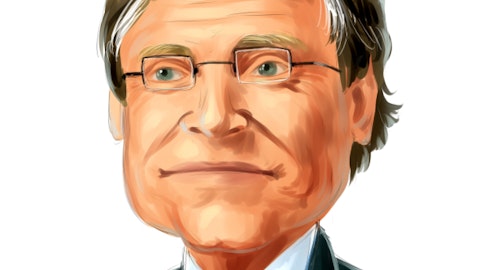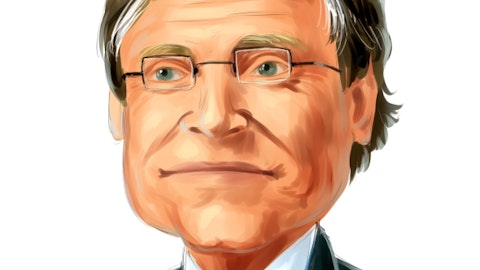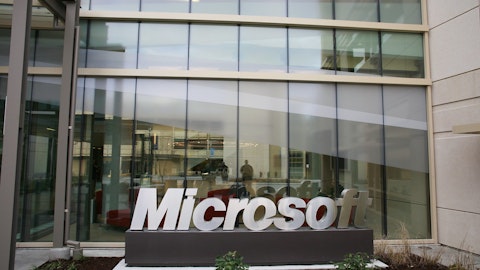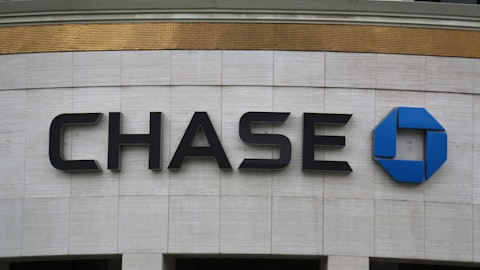Caterpillar Inc. (NYSE:CAT) Q3 2023 Earnings Call Transcript October 31, 2023
Operator: Ladies and gentlemen, welcome to the Third Quarter 2023 Caterpillar Earnings Conference Call. Please be advised that today’s conference is being recorded. I would now like to hand the conference over to your speaker today, Ryan Fiedler. Thank you, and please go ahead.
Ryan Fiedler: Thanks, Abby. Good morning, everyone, and welcome to Caterpillar’s third quarter of 2023 earnings call. I’m Ryan Fiedler, Vice President of Investor Relations. Joining me today are Jim Umpleby, Chairman and CEO; Andrew Bonfield, Chief Financial Officer; Kyle Epley, Senior Vice President of the Global Finance Services Division; and Rob Rengel, Senior IR Manager. During our call, we’ll be discussing the third quarter earnings release we issued earlier today. You can find our slides, the news release, and a webcast recap at investors.caterpillar.com under Events and Presentations. The content of this call is protected by US and international copyright law. Any rebroadcast, retransmission, reproduction, or distribution of all or part of this content without Caterpillar’s prior written permission is prohibited.
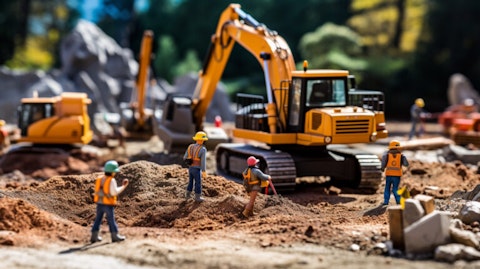
A construction site with heavy equipment and people in hard hats working on the next infrastructure project.
Moving to Slide 2. During our call today, we’ll make forward-looking statements, which are subject to risks and uncertainties. We’ll also make assumptions that could cause our actual results to be different than the information we’re sharing with you on this call. Please refer to our recent SEC filings, and the forward-looking statements reminder in the news release for details on factors that individually, or in aggregate, could cause our actual results to vary materially from our forecast. A detailed discussion of our many factors that we believe may have a material effect on our business, on an ongoing basis, is contained in our SEC filings. On today’s call, we’ll also refer to non-GAAP numbers. For a reconciliation of any non-GAAP numbers to the appropriate US GAAP numbers, please see the appendix of the earnings call slides.
Now, let’s turn to Slide 3, and turn the call over to our Chairman and CEO, Jim Umpleby.
Jim Umpleby: Thanks, Ryan. Good morning, everyone. Thank you for joining us. Before discussing our results, I’d like to take a moment to acknowledge the tragic events in the Middle East. We are deeply saddened by the loss of life, and are hopeful for a quick and peaceful resolution. The Caterpillar Foundation is donating $1 million to the American Red Cross, and its network of Red Crescent Societies in the region, to support the humanitarian needs of those impacted. As we closed out the third quarter, I want to thank our global team for delivering another strong quarter. This included double-digit top line growth, strong adjusted operating profit margin, and robust ME&T free cash flow. Our results continue to reflect healthy demand across most of our end markets for our products and services.
We remain focused on executing our strategy, and continue to invest for long-term profitable growth. I’ll begin with my perspectives about our performance in the quarter. I’ll then provide some insights about our end markets. Lastly, I’ll provide an update on our sustainability journey. Moving to quarterly results, it was another strong quarter. Sales and revenues increased 12% in the third quarter versus last year. Adjusted operating profit margin improved to 20.8%, up significantly year-over-year. We also generated $2.9 billion of ME&T free cash flow in the quarter. Sales were generally in line with our expectations, while both adjusted operating profit margin, and ME&T free cash flow in the third quarter were better than we expected. In addition, we ended the quarter with a healthy backlog of $28.1 billion.
Backlog is a function of demand and lead times. As I’ve mentioned, demand remains healthy in most of our end markets. Due to improving supply chain conditions, product availability and lead times have improved for many products. Dealers and customers can wait longer to place orders, which has led to a moderation in order rates, as expected. In addition, we have seen a reduction in dealer orders for building construction products, which we anticipated, due to the changeover to CAT engines that we previously discussed, and for excavation, in anticipation of dealers reducing their inventories in the fourth quarter. Although, our backlog declined as expected, it still remains elevated as a percentage of revenues compared to historic levels. While we continue to closely monitor global macroeconomic conditions, we now expect our full-year 2023 results to be better than we anticipated during our last earnings call.
Turning to Slide 4. In the third quarter of 2023, sales and revenues increased by 12% to $16.8 billion, driven primarily by favorable price realization, as well as volume growth. Sales increased in each of our three primary segments. Compared with the third quarter of 2022, overall sales to users increased 13%, which was below our expectations. Energy & Transportation sales to users increased 34%, but was lower than expected due to some supply chain challenges for large engines, and the timing of gas turbine in international locomotive deliveries. For machines, which includes Construction Industries and Resource Industries, sales to users rose by 7%, in line with expectations. Sales to users in Construction Industries were up 6%. North American sales to users increased as demand remained healthy for non-residential, and residential construction.
Non-residential continued to benefit from government-related infrastructure and construction projects. Residential sales to users in North America also increased in the quarter. EAME sales to users were up slightly, primarily due to continuing strength in Middle East construction activity. In Latin America and Asia-Pacific, sales to users declined in the quarter. In Resource Industries, sales to users increased 10%. In mining, sales to users increased with commodities remaining above investment thresholds. Within heavy construction, and quarry and aggregates, sales to users also increased, supported by growth for infrastructure-related projects. In Energy & Transportation, sales to users increased by 34%. All applications saw higher sales to users in the quarter.
Oil and gas sales to users benefited from strong sales of turbines, and turbine-related services. We also saw continued strength in sales of reciprocating engines into oil and gas applications such as Tier 4 dynamic gas blending, repowering well servicing fleets and gas compression. Power generation sales to users continued to remain positive, due to favorable market conditions, including strong data center growth. Industrial and transportation sales to users also increased. Dealer inventories increased by $600 million in the quarter, led by Construction Industries and followed by Energy & Transportation. In Construction Industries, the increase was in North America in some of our most constrained product lines including BCP and Earthmoving.
We remain very comfortable with the total level of dealer inventory, which is within the typical range. Andrew will provide more color later in the call. Adjusted operating profit margin increased to 20.8% in the third quarter, a 430 basis point increase over last year. Adjusted operating profit margin was better than we had anticipated. Relative to our expectations, we saw lower-than-expected manufacturing costs, including freight, as well as slightly favorable price realization, which included the positive impact from geographic mix. Moving to Slide 5. We generated strong ME&T free cash flow of $2.9 billion in the third quarter, and $6.8 billion in the first three quarters of 2023. Year-to-date, we returned $4.1 billion to shareholders, which included about $2.2 billion of repurchased stock, and $1.9 billion in dividends.
We remain proud of our Dividend Aristocrat status, and continue to expect to return substantially all ME&T free cash flow to shareholders over time through dividends and share repurchases. Now on Slide 6, I’ll describe our expectations moving forward. As I mentioned earlier, we now anticipate the full year to be better than we previously expected. We expect our adjusted operating profit margin to be slightly above the targeted range relative to the corresponding level of sales. This positive operating performance increases our expectations for ME&T free cash flow, which we now expect will exceed the $4 billion to $8 billion target range for the full year. This outlook for the adjusted operating profit margin, and ME&T free cash flow, reflects healthy customer demand and our strong operating performance.
Now, I’ll discuss our outlook for key end markets starting with Construction Industries. In North America overall, we continue to see positive momentum. We expect continued growth in non-residential construction in North America due to the impact of government-related infrastructure investments, and a healthy pipeline of construction projects. Although, residential construction growth has moderated, we expect it to remain healthy. In Asia Pacific, excluding China, we expect growth in Construction Industries due to public infrastructure spending, in support of commodity prices. As we have mentioned during previous earnings calls, we anticipate continued weakness in China, and expect it to remain well below our typical range of 5% to 10% of enterprise sales.
In EAME, we anticipate the region will be slightly down as weakness continues in Europe, partially offset by continuing strong construction demand in the Middle East. Construction activity in Latin America is expected to be about flat versus strong 2022 performance. In Resource Industries, we continue to see a high level of quoting activity. In mining, customer product utilization remains high. The number of parked trucks remains low, and the age of the fleet remains elevated. Order rates are slightly lower than we expected at this time, reflecting continued capital discipline by our customers. We continue to believe the energy transition will support increased commodity demand over time, expanding our total addressable market, and providing further opportunities for long-term profitable growth.
In addition, customer acceptance of our autonomous solutions continues to grow. This is evidenced by the announcement this morning with Freeport-McMoRan, who will convert their fleet of Cat 793 large mining trucks at an Arizona copper mine to autonomous haulage using Cat MineStar Command. We also expect heavy construction, and quarry and aggregates to remain in healthy levels due to major infrastructure in non-residential construction projects. Moving to Energy & Transportation. In oil and gas, we remain encouraged by continuing strong demand for Cat reciprocating engines and gas compression. As we said last quarter, well servicing in North America is showing some short-term moderation, but we remain optimistic about future demand. Cat reciprocating engine demand for power generation is expected to remain strong, primarily driven by data center growth.
New equipment and services for solar turbines in both oil and gas and power generation remain robust. Industrial demand is expected to soften slightly from recent high levels, but remains well above our historical averages. In transportation, we anticipate strength in high-speed marine as customers continue to upgrade aging fleets. As we’ve described, we continue to see strength in most of our end markets. Based on our backlog, dealer inventory, and current market conditions, we expect to have another good year in 2024. We will provide additional information during our fourth quarter call. Moving to Slide 7. We continue to advance our sustainability journey. We’re helping our customers achieve their climate related objectives by continuing to invest in new products, technologies, and services, that facilitate fuel flexibility, increased operational efficiency, and reduced emissions.
For example, Caterpillar provides a number of low-carbon intensity solutions to customers. In Construction Industries, the Cat 980 XE Wheel Loader, which features a Cat designed and manufactured continuous variable transmission, improves fuel efficiency by as much as 35%, and reduces CO2 emissions by as much as 17% compared to the previous model. We also introduced the new Cat G3600 Gen 2 engine, the latest evolution of the powerful G3600 series, offering lower emissions. With more than 8,500 Cat G3600 units in the field, the Gen 2 engine is designed to build upon the platform’s robust performance, to provide a 10% increase in power, and lower emissions compared to the previous model. We’ve also made several joint announcements with customers that demonstrate our commitment to supporting their climate-related objectives.
I’ll highlight one here. In September, Caterpillar and Albemarle introduced a unique collaboration, aimed to support their efforts to establish Kings Mountain, North Carolina as the first-ever zero emissions lithium mine in North America, while also making lithium available for use in Caterpillar battery production. These examples reinforce our ongoing sustainability leadership, and how we’re helping our customers build a better, more sustainable world. With that, I will turn it over to Andrew.
Andrew Bonfield: Thank you, Jim, and good morning, everyone. I’ll begin with commentary on the third quarter results, including the performance of our segments. Then, I’ll discuss the balance sheet and cash flow, before concluding with our assumptions for the fourth quarter and full year. Beginning on Slide 8. Our overall operating performance was strong. Adjusted operating profit margin, adjusted profit per share, and ME&T free cash flow, all were better than we expected, while sales grew in line with our expectations. Based on the strong third quarter, and year-to-date operating performance, we now expect that the adjusted operating profit margin for the year will be slightly above the top end of our target range, at the corresponding level of sales.
We also anticipate that ME&T free cash flow will exceed the target range of $4 billion to $8 billion. In summary, sales and revenues increased by 12% or $1.8 billion to $16.8 billion. The sales increase versus the prior year was driven by — primarily by price realization, as well as higher sales volume. Operating profit increased by 42% or $1 billion to $3.4 billion. The adjusted operating profit margin was 20.8%, an increase of 430 basis points versus the prior year. Profit per share was $5.45 in the third quarter of this year. This included restructuring costs of $0.07 per share as compared to $0.08 in the prior year. We continue to expect restructuring expenses of about $700 million for the full year. Adjusted profit per share increased by 40% to $5.52 in the third quarter compared to $3.95 last year.
Other income of $195 million was lower than that — than the third quarter of 2022 by $47 million. The decline was driven by less favorable currency impacts in the quarter, related to ME&T balance sheet translation, as compared to the prior year, along with the recurring increase and a pension expense of approximately $18 million per quarter. Higher investment and interest income acted as a partial offset. The provision for income taxes in the third quarter, excluding discrete items, reflected a global annual effective tax rate of 22.5%, which is the rate we now expect for the full year. The slightly lower-than-expected tax rate, along with discrete items, added about $0.14 to profit per share in the quarter. Moving on to Slide 9. As I mentioned, the 12% increase in the top line versus the prior year was primarily due to price realization, as well as higher sales volume.
Volume improved as sales to users increased by 13% while year-over-year changes in dealer inventory acted as a slight offset. Overall, the magnitude of the sales increase was in line with our expectations. However, by segment, construction Industries sales were higher, Resource Industries sales were in line, and Energy & Transportation sales were lower than we had anticipated. Services revenues increased in the third quarter. We will update you with our progress towards our services growth target when we report our fourth quarter results, and as is our normal practice. Price realization was slightly better than we had anticipated for the quarter. However, as we anticipated, we did see the magnitude of the year-over-year price effects moderate compared to the second quarter, as we lap the prior-year price increases.
Volume was slightly below our expectations. As Jim mentioned, sales to users were lower than we had anticipated, principally in Energy & Transportation. However, this was nearly offset by the increase in dealer inventory versus our expectations of being about flat for the quarter. The increase in dealer inventory was driven primarily by Construction Industries. There, we had stronger-than-expected shipments in North America, particularly in building construction products, and earthmoving. Within North America, these products remain constrained, and are near the bottom end of the typical dealer inventory range of three to four months of sales. We also saw some dealer inventory increase in Energy & Transportation within the quarter. I’ll remind you that dealer inventory in Energy & Transportation and Resource Industries is mainly a function of the commissioning pipeline, with over 70% of dealer inventory in these segments backed by firm customer orders.
Because dealer inventory is more a functioning — function of commissioning in Resource Industries and Energy & Transportation, it is difficult for us to predict in these two segments. I will discuss further our full-year expectations for dealer inventories a little bit later. Moving to Slide 10. Third quarter operating profit increased by 42% to $3.4 billion, while adjusted operating profit increased by 41% to $3.5 billion. Price realization, which included a slight benefit from a shift in the geographic mix of sales and sales volume were favorable in the quarter. Our largest headwinds to operating profit were higher SG&A and R&D expenses, and higher manufacturing costs. SG&A and R&D expenses included higher strategic investment spend. Manufacturing cost increases included higher material costs, and unfavorable cost absorption, as we reduced our inventories compared to a corresponding increase in the third quarter of 2022.
Lower freight costs acted as a partial offset within manufacturing costs. The adjusted operating profit margin of 20.8% improved by 430 basis points. This was better than we had anticipated, primarily due to favorable manufacturing costs, of which freight was the largest contributor. Also, the slightly better-than-expected price helped margins. Now, I’ll discuss the performance of the segments. On Slide 11, Construction Industries sales increased by 12% in the third quarter to $7 billion, primarily due to favorable price realization. By region, sales in North America rose by 31% due to higher sales volume and favorable price. As I mentioned, supply chain improvements enabled stronger-than-expected shipments in North America, which supported some dealer restocking.
Sales of equipment to end users were in line with our expectations for the region. Sales in Latin America decreased by 31%, primarily due to lower sales volume, partially offset by favorable price. In EAME, sales increased by 8%, mainly due to favorable price and currency impacts. Sales in Asia Pacific decreased by 8%, primarily due to lower sales volume, driven by lower sales of equipment to end users. Third quarter profit for Construction Industries increased by 53% versus the prior year to $1.8 billion. The increase was mainly due to favorable price realization. The segment’s operating margin of 26.4% was an increase of 710 basis points versus last year. Margin exceeded our expectations on better volume, price, and lower-than-anticipated manufacturing costs, primarily freight.
Turning to Slide 12, Resource Industries sales grew by 9% in the third quarter to $3.4 billion. The increase was primarily due to favorable price realization, partially offset by lower sales volume. Volume decreased as higher sales of equipment to end users were more than offset by lower aftermarket [sale parts] (ph) volume, which reflected changes in dealer buying patterns. Third quarter profit for Resource Industries increased by 44% versus the prior year to $730 million, mainly due to favorable price realization. Profit was partially offset by the by the impact of lower sales volume, which included unfavorable product mix. The segment’s operating margin of 21.8% was an increase of 540 basis points versus last year. Margin was better than we had expected, primarily due to lower-than-anticipated manufacturing costs, driven by freight and price.
Now on Slide 13. Energy & Transportation sales increased by 11% in the third quarter to $6.9 billion. Sales were up across all applications. Oil and gas sales increased by 26%, power generation sales were higher by 21%, industrial sales rose by 5% and transportation sales increased by 6%. Third quarter profit for Energy & Transportation increased by 26% versus the prior year to $1.2 billion. The increase was mainly due to favorable price realization, and higher sales volume, partially offset by higher SG&A and R&D expenses, unfavorable manufacturing costs, and currency impacts. SG&A and R&D expenses reflected ramping investments related to strategic growth initiatives. As a reminder, the most of our strategic investments relating to electrification and alternative fuels occur in this segment, which impacts reported margins.
The segment’s operating margin of 17.2% was an increase of 210 basis points versus the prior year. Margin was lower than we had anticipated, primarily due to lower-than-expected sales volume, impacted by supply chain challenges for large engines, and delivery delays for solar turbines. Moving to Slide 14. Financial Products revenue increased by 20% to $979 million, primarily due to higher average financing rates across all regions. Segment profit decreased by 8% to $203 million. The decrease was mainly due to a higher provision for credit losses at Cat Financial. The unfavorable impact reflects a challenging comparison as we had reserve releases in the prior year, as compared to a more typical provision expense in the third quarter of 2023.
Of note though, through the third quarter of this year, provision expense for a comparable nine-month period is at the lowest level for over 20 years. Business activity remains strong with our — and our portfolio continues to perform well, with past dues and write-offs at historic low levels. Past dues in the quarter were 1.96%, a 4 basis point improvement compared to the third quarter of 2022, and a decrease of 19 basis points compared to the second quarter. Retail new business volume increased versus the prior year, and though it declined compared to the second quarter, this follows the typical seasonal pattern. In addition, we continue to see strong demand for used equipment, and used inventory remains at low levels. Now on Slide 15. Our ME&T free cash flow has been robust this year with another $2.9 billion generated during the third quarter.
With $6.8 billion generated through the first three quarters of this year, we expect to exceed our target of $4 billion to $8 billion this year. From a working capital perspective, we had a small inventory decrease of around $200 million in the quarter. Looking ahead, we expect our inventory levels will continue to decrease as we’ve seen sustained supply chain improvement. CapEx in the third quarter was around $400 million. With about $1.1 billion in CapEx through the first three quarters, we continue to expect around $1.5 billion for the full year. Our balance sheet remains strong. We have ample liquidity with an enterprise cash balance of $6.5 billion, and we hold an additional $4.3 billion in slightly longer-dated liquid marketable securities to improve yields on that cash.
Now on Slide 16. I will share some high-level assumptions for the fourth quarter and the full year. During the fourth quarter, we anticipate slightly higher sales as compared to the prior year. Price should remain favorable. We expect sales to users to continue to support good underlying growth, though, changes in dealer inventories should act as an offset. As a reminder, we saw dealers increase inventories by $700 million in the fourth quarter of 2022, whilst we expect a decrease in the fourth quarter of this year. Specifically in Construction Industries, we do not expect the seasonal sales increase typically seen from the third to the fourth quarter. Those sales to users are expected to increase on both a sequential and year-over-year basis.
Instead, we anticipate lower shipment volumes, as we complete the Cat engine changeover in building construction products, and dealers reduced their inventories, principally of excavators. This compares to a dealer inventory increase in the fourth quarter of 2022. Though we now expect that dealer inventory in Construction Industries will be higher at the end of 2023 than it was at year end 2022, we still expect it to be within the typical three to four months of sales range. A reminder, this is an average across all dealers and all products in Construction Industries, and it’s difficult to predict with precision, given over 150 independent dealers, and hundreds of different products. Similar to last quarter, there are still areas and/or products where dealers would like to have more inventory.
As Jim has mentioned, we are very comfortable with the level of inventory held by dealers overall. In Resource Industries, we anticipate slightly lower sales as compared to the third quarter, as a result of improvements in availability. We also expect lower sales versus the prior year, driven by changes in dealer inventory. In the fourth quarter of 2022, there was an increase in dealer inventories for Resource Industries, while we expect a decrease in the fourth quarter of this year. We expect sales in Energy & Transportation to increase in the fourth quarter as compared to the third quarter, with higher solar turbines and rail deliveries. However, keep in mind that we continue to work through supply chain challenges, primarily impacting large engines.
We also anticipate some moderation in industrial sales during the fourth quarter, compared to recent high levels. Now, I’ll comment on our expectations for margins. We provided our adjusted operating profit margin target charge to assist you in your modeling process. Based on our current planning assumptions, we anticipate the adjusted operating profit margin to be slightly above the target range for the full year 2023. This is based on the corresponding estimated level of sales. Your expectation for total enterprise sales this year will inform where margins could finish for the year. Specific to the fourth quarter, we anticipate the adjusted operating profit margin to be lower than the third quarter. We anticipate lower-than-normal volume leverage, particularly impacting Construction Industries, for the reasons I mentioned previously.
We also anticipate a negative segment mix impact to impact operating margins, as Construction Industries sales would be a lower proportion of total sales, as compared to the third quarter. Price realization should remain positive, though we expect the magnitude of the favorability versus the prior year to moderate as we continue to lap more favorable pricing trends from last year. Therefore, the increases in margins that have occurred from price outpacing manufacturing cost inflation, should moderate in the fourth quarter. In addition, as you look down the income statement for the prior year, there are a couple of points to note. First, short-term incentive expense in the fourth quarter of 2022 was lower than normal due to the true up for the final outcomes for the financial year.
This will be a headwind for year-over-year operating margins. However, this will be partially offset by favorability in other operating income and expense, as we do not expect the significant currency translation losses that we saw in the fourth quarter of last year to recur. By segment, in Construction Industries, we expect slightly lower margin compared to the third quarter, assuming lower volume. We also anticipate lower sequential margins in Resource Industries, as is typical, impacted by cost absorption, along with higher spend, relating to strategic investments. In Energy & Transportation, we expect margins will be similar to the third quarter, with stronger volume offset by manufacturing costs, and an unfavorable mix of products, which includes international locomotive deliveries in rail.
Now turning to Slide 17, let me summarize. Adjusted profit per share was $15.98 through the first three quarters of the year, which already exceeds our previous full year record by 15%. We generated strong adjusted operating profit margin, with a 430 basis point increase to 20.8%. We now expect to be slightly above the targeted range for adjusted operating profit margin for the full year, based on our expected sales levels. ME&T free cash flow remained robust with $6.8 billion year-to-date. We now expect ME&T free cash flow to exceed our $4 billion to $8 billion target range for the full year. We continue to execute our strategy for long-term profitable growth. And with that, we’ll take your questions.
See also 12 Best Travel Stocks To Buy Right Now and 30 Best School Districts in USA.
Q&A Session
Follow Caterpillar Inc (NYSE:CAT)
Follow Caterpillar Inc (NYSE:CAT)
Operator: [Operator Instructions] And your first question comes from Michael Feniger with Bank of America. Your line is open.
Michael Feniger: Yeah, thank you for taking my question. Just based on where the backlog sits today, you discussed the easing supply conditions impacting lead times, orders. As that normalizes, do you expect the backlog to consolidate at these levels and then move higher? You mentioned some capital discipline with customers. Just [Technical Difficulty] Jim with where commodity prices are for oil, iron ore, copper, is that enough to support growth in 2024? Thank you.
Jim Umpleby: Yeah, as I mentioned, we do expect another good year in 2024, and we’ll provide more detail in January. We talked about this a bit in our last quarterly call. Our backlog is higher than it normally would be because our lead times are higher than I’d like them to be frankly, and what we’ve talked about is as supply conditions continue to improve, we expect lead times to come down, which should have a corresponding impact on our backlog. Our backlog should come down, so that’s a positive thing. If you look at our backlog over a number of years, it’s still elevated compared to where it normally would be, based on revenue. So again, we do feel good about market conditions, and we expect that as we improve lead times that backlog as a percentage of revenue would come down to more normal levels.
Andrew Bonfield: Yeah, let me just give you some numbers to add to that. I mean, if you look at the backlog as a percentage of trailing 12-month revenues in the period of 2017, it was 37%, in 2018, it was 32%. Currently today, it’s around 44%. So, backlog still is elevated based on historic trends, and remind you also that services revenues now are a higher proportion of our total revenue base as well.
Operator: And we will take our next question from Tami Zakaria with JP Morgan. Your line is open.
Tami Zakaria: Hi, good morning. Thank you so much. So, staying on backlog…
Jim Umpleby: Morning, Tami.
Tami Zakaria: Thank you. Staying on backlog, I think orders were down in the third quarter. Have you seen any improvement in order trends quarter-to-date, or if orders continue to be down, what would support a good year in 2024, like you mentioned in your call?
Jim Umpleby: Yeah. Again, we expected some moderation in order rates based on, again, improving availability, so that wasn’t a surprise to us. Again, what would give us another good year in 2024 is market conditions. I mean, again, if we look at where we are in most of the markets we serve, we feel quite good, starting with just with Construction Industries in North America, the infrastructure investments that are being made by the government, although we are starting, we have seen some benefit of that, we expect more benefit in 2024 residential, although the growth rate has continued to moderate in North America, it is still growing, and oil and gas still remains quite healthy for solar turbines. Gas compression in oil and gas is strong as well. So, again, there’s a lot of positive things. Power generation, data center growth, continues to provide a tailwind as well. So again, the market conditions would lead us to believe that we’ll have another good year next year.
Andrew Bonfield: And, Tami, just to add, again, a little bit more. Remind you that specifically in the third quarter, there were two factors which did impact order rates, one which is, obviously, as we’ve talked about the Cat engine changeover for a number of quarters, that happening in the fourth quarter. If you think about when dealers will place orders for BCP machines, they would tend to impact us in the third quarter, which is why we saw those order rates decline. Similarly, we also saw some excavator orders decline in anticipation of dealers reducing their inventory levels as well. So overall, those are specific factors in the third quarter results, which actually moderated the overall order rates as well.
Jim Umpleby: Maybe just another comment about the BCP changeover. We deliberately limit the number of orders because we have a fixed amount of machines being built prior to that changeover to the new model. And then we close the order board at some point when we run out of allocation spots, and we haven’t yet opened the order board for the new model. So again, that helps explain the reduction in order rates for BCP around that engine changeover. And again, as expected, we also have talked about the fact that we expect dealers to bring down excavator inventory. And again, that would reflect — that would result in a lower order rate as well for CI for excavators. So, again, none of this is surprising.
Operator: And we’ll take our next question from Rob Wertheimer with Melius Research. Your line is open.
Rob Wertheimer: Yes, hi. My question is on resources, and it’s going to be basically on business model, revenue model, and margin. And so, you announced the deal with Freeport today on retrofit of autonomous mining trucks, and I know you’ve had retrofit for a while. I don’t recall an announcement quite this big, although maybe I’ve missed one or two. But the question is, really, as you see deals like that, you deliver value to customers through autonomous operations, saving direct and indirect costs, how do you think about margin support for you guys? And then, how do you think about market share going forward? I think a year ago, you’d sort of run a large majority of autonomous mining contracts, or tenders out there, and I’m wondering if you can give us an update on that. So kind of market share margin and business development. Thank you.
Jim Umpleby: You bet. And Rob, we have talked in the past about the fact that we are very bullish about our autonomous solution. We do believe we have the best solution in the industry because our trucks move faster, and we’re able to allow our customers to produce more commodity in a 24-hour period. We continue to invest in our autonomous capabilities, and continue to add more value, and that’s really resulting in us receiving the orders like the ones that — the one that was announced this morning. Certainly, we’re always striving to add more value that helps, again, it’s not just about cost competition, it’s providing more value to customers to make them more successful. We had talked about the fact that our customers in mining are displaying capital discipline.
That’s not surprising. Quotation activity is quite high, and number of parked trucks is low. So again, if one thinks about the energy transition, combines that with our autonomous solution, we do feel good about Resource Industries, particularly in mining moving forward.
Operator: And we’ll take our next question from David Raso with Evercore. Your line is open.
David Raso: Hi, thank you for the time. The question is on the fourth quarter margins. I know the framework you historically work within for providing margin guidance, but I must say the fourth quarter, I mean, it’s implying a range of EPS that you can drive a truck through. So, I’m just trying to get a little better sense of — I think I heard you say the margins in CI and RI slightly below the third quarter, and E&T similar. But then when you give that range of [whatever] (ph) you think your sales are, I mean, we have a rough idea of what you’re thinking for sales given the fourth quarter guide. I’m just trying to get a sense of margins year-over-year at least appear that they’ll be up. Is that a fair statement? But the slight on RI and CI almost make it seem like it’s down only 100 bps or 150 bps sequentially. So, I apologize for the granularity, but it’s just a wide range. I just want to make sure we understand. Thank you.

